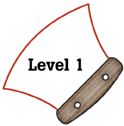
Alaska Science
Key Element A8a
A student who meets the content standard should understand the scientific principles and models that describe the nature of physical, chemical, and nuclear reactions (Energy Transformations).
 |
Alaska Science A student who meets the content standard should understand the scientific principles and models that describe the nature of physical, chemical, and nuclear reactions (Energy Transformations). |
|
Performance Standard Level 1, Ages 5–7
|
|
|
|
Sample Assessment Ideas
|
|
|
Expanded Sample Assessment Idea
|
|
Procedure Students will:
Reflection and Revision
|
Levels of Performance |
||
|
Stage 4 |
Student drawings show detailed evidence of knowledge about reversible changes that happen to water. Drawing #1 of the demonstration shows what happened during each step of the ice to water demonstration. Drawing #2 shows another way to change the form of water other than the process used in the classroom demonstration. Drawing #3 shows the three steps in the water cycle. Student explanation is correct, complete and shows evidence of logical reasoning. | ||
|
Stage 3
|
Student drawings show evidence of knowledge about reversible changes that happen to water. Drawing #1 of the demonstration shows what happened during the steps of the ice to water demonstration. Drawing #2 may show another way to change the form of water other than the process used in the classroom demonstration. Drawing #3 shows two steps in the water cycle. Student explanation shows evidence of logical reasoning but may contain minor errors or omissions. | ||
|
Stage 2
|
Student drawings show limited evidence of knowledge about changes that happen to water. Drawings may contain evidence of skilled artwork but may be incomplete, incorrect or lack detail. | ||
|
Stage 1
|
Student drawings show little or evidence of knowledge about changes that happen to water. Drawings may be largely incomplete or incorrect and show little evidence of understanding. | ||
Standards Cross-References
|
||
|
National Science Education Standards Materials can exist in different states—solid, liquid, and gas. Some common materials such as water can be changed from one state to another by heating or cooling. (Page 127) |
Benchmarks Things can be done to materials to change some of their properties, but not all materials respond the same way to what is done to them. (Page 76) |
|
Table of Contents | Return to Alaska Native Knowledge Network